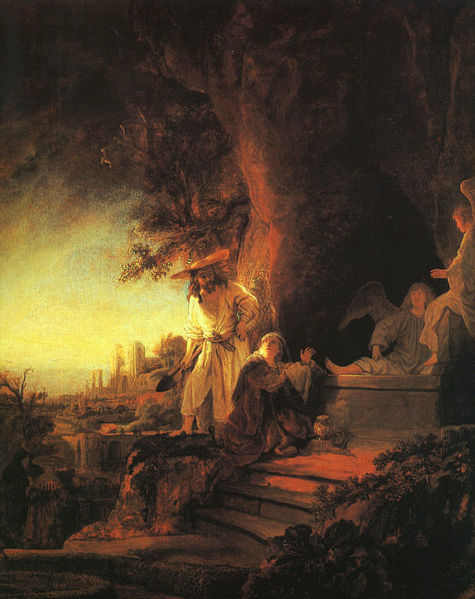
* * * *
Last Thursday, July 22, was the Feast Day for Mary from Magdala. She is a saint, and the only reason I put the word in quotes is that she ended up a saint despite the best efforts of jealous male disciples. (Because she showed more courage than they did when it counted.)
And that “showing more courage” seems to be why she got the reputation for a “sordid past.” On the other hand, there’s the opinion of St. Augustine, who referred to her as the “Apostle to the Apostles.” On that note see also Mary of Magdala | FutureChurch:
Mary of Magdala is perhaps the most maligned and misunderstood figure in early Christianity… Since the fourth century, she has been portrayed as a prostitute and public sinner… Paintings [of her], some little more than pious pornography, reinforce the mistaken belief that sexuality, especially female sexuality, is shameful, sinful, and worthy of repentance. Yet the actual biblical account of Mary of Magdala paints a far different portrait than that of the bare-breasted reformed harlot of Renaissance art.
The one indisputable fact seems to be that Mary Magdalene was both the first person to see the empty tomb of Jesus, and one of the first – if not the first – to see the risen Jesus.
As for the Crucifixion itself, only one Gospel had a male disciple at the scene, John. (In “his*” Gospel, Ch. 19. Or see Who Was Present at the Cross?) But many women were there, as noted in Mark 15:40: “Some women were watching from a distance. Among them were Mary Magdalene, Mary the mother of James the younger and of Joseph, and Salome.”
And John, Chapter 20 tells the full story of Mary Magdalene being both the first to see the empty tomb and the first to see the Risen Jesus, as shown in the painting below.
For starters, see John 20:1: “Early on the first day of the week, while it was still dark, Mary Magdalene went to the tomb and saw that the stone had been removed from the entrance.” She went to tell Peter and John, who checked the tomb, then “went back to where they were staying.” But Mary – faithful Mary, of the lousy reputation – stayed, as noted in John 20:11-18. She saw two angels, then turned to see another man she took to be a caretaker:
Supposing him to be the gardener, she said to him, “Sir, if you have carried him away, tell me where you have laid him, and I will take him away.” Jesus said to her, “Mary!” She turned and said to him in Hebrew, “Rabbouni!” (which means Teacher). Jesus said to her, “Do not hold on to me, because I have not yet ascended to the Father. But go to my brothers and say to them, I am ascending to my Father and your Father, to my God and your God.’” Mary Magdalene went and announced to the disciples, “I have seen the Lord;” and she told them that he had said these things to her.
Which is why this Mary – from Magdala – is rightly known as the “Apostle to the Apostles.”
* * * *

* * * *
I gleaned the text and two illustrations from past posts: Mary Magdalene, “Apostle to the Apostles” (2015), Mary of Magdala and James the Greater, Saints (2017), Mary Magdalene, and “conserving talents…” (2018), Mary Magdalene – and all those “rules and regulations…” (2019), and from last year at this time, Mary Magdalene, 2020 – and Week 19 of “the Covid.”
More specifically, the lower image is courtesy of Rembrandt – The Risen Christ. The full caption: “The Risen Christ Appearing to Mary Magdalen, by Rembrandt (1638).” And speaking of “racy,” Titian did two versions of Mary. For the “racy” (1533) version see Penitent Magdalene (Titian, 1533) – Wikipedia.
The Penitent Magdalene is a 1565 oil painting by Titian of saint Mary Magdalene, now in the Hermitage Museum in Saint Petersburg. Unlike his 1533 version of the same subject, Titian has covered Mary’s nudity and introduced a vase, an open book and a skull as a memento mori. Its coloring is more mature than the earlier work, using colors harmoni[z]ing with character. In the background the sky is bathed in the rays of the setting sun, with a dark rock contrasting with the brightly lit figure of Mary.